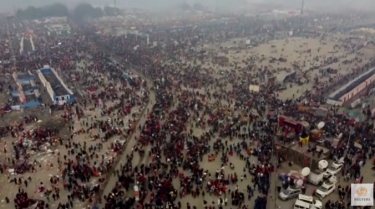
A judicial commission began its investigation on Friday, 31 January, into the deadly stampede at Prayagraj’s Maha Kumbh that claimed 30 lives and left 60 injured during the auspicious Mauni Amavasya celebrations on 29 January. The tragedy was followed by a fire incident on 30 January that destroyed 15 tents in the mela area, marking a challenging period for one of humanity’s largest religious gatherings.
The three-member commission, headed by retired Allahabad High Court judge Harsh Kumar, visited the Sangam area to inspect the site where the stampede occurred. The panel, which includes former Director General of Police VK Gupta and retired IAS officer DK Singh, is expected to submit its report within a month.
The stampede occurred between 1 and 2 a.m. on Wednesday, 29 January, when crowds broke through barricades at the Sangam area, where millions had gathered for a holy dip on Mauni Amavasya. DIG Vaibhav Krishna confirmed that 25 of the victims have been identified, with at least 36 of the injured currently receiving medical treatment.
A Karnataka resident, Sarojini, who witnessed the tragedy, told PTI, “We came in a batch of 60 people in two buses. There were nine people in our group. Suddenly there was pushing in the crowd, and we got trapped. Many fell down and the crowd became uncontrollable.”
Adding to the challenges, a fire broke out in Sector 22 of the mela area on 30 January. Chief Fire Officer Pramod Sharma reported that while 15 tents were destroyed, there were no casualties. The fire-fighting effort was hampered by limited road access, though crews eventually brought the situation under control. This incident follows an earlier fire on 19 January 2025 that had destroyed 180 cottages in the Gita Press camp, where the blaze was reportedly caused by a gas leak during tea preparation.
The stampede prompted the Uttar Pradesh government to enhance crowd management measures. Despite the incidents, over 1.52 crore devotees had taken the holy dip by 2 p.m. on Thursday. Authorities are now focusing on preparations for the upcoming Amrit Snan on Basant Panchmi on 3 February.
The 45-day Maha Kumbh, occurring after a gap of 144 years, began on 14 January at the confluence of the Ganga, Yamuna, and the mythical Saraswati rivers. The event is expected to draw over 45 crore devotees, including approximately 15 lakh international visitors, making it the largest religious gathering globally.
The state government has allocated Rs 7,000 crore for the event, implementing modern security measures including underwater drones and AI-enabled cameras. Teams from PAC, NDRF, and SDRF have been deployed on 700 flagged boats to ensure devotee safety.
The incident has drawn political attention, with Congress president Mallikarjun Kharge criticising the arrangements. “Half-baked arrangements, VIP movement, paying more attention to self-promotion and mismanagement are responsible for this,” Kharge posted on X, urging both central and state governments to improve systems for future events.
Chief Minister Yogi Adityanath announced compensation of Rs 25 lakh for families of the deceased and ordered an in-depth probe into the incident. The state’s chief secretary and DGP are scheduled to visit the Maha Kumbh for a detailed investigation.
Despite the tragedies, the religious significance of the event remains paramount, particularly this year with the rare celestial alignment called ‘Triveni Yog’ occurring after 144 years, amplifying the spiritual importance of the gathering for millions of devotees.




